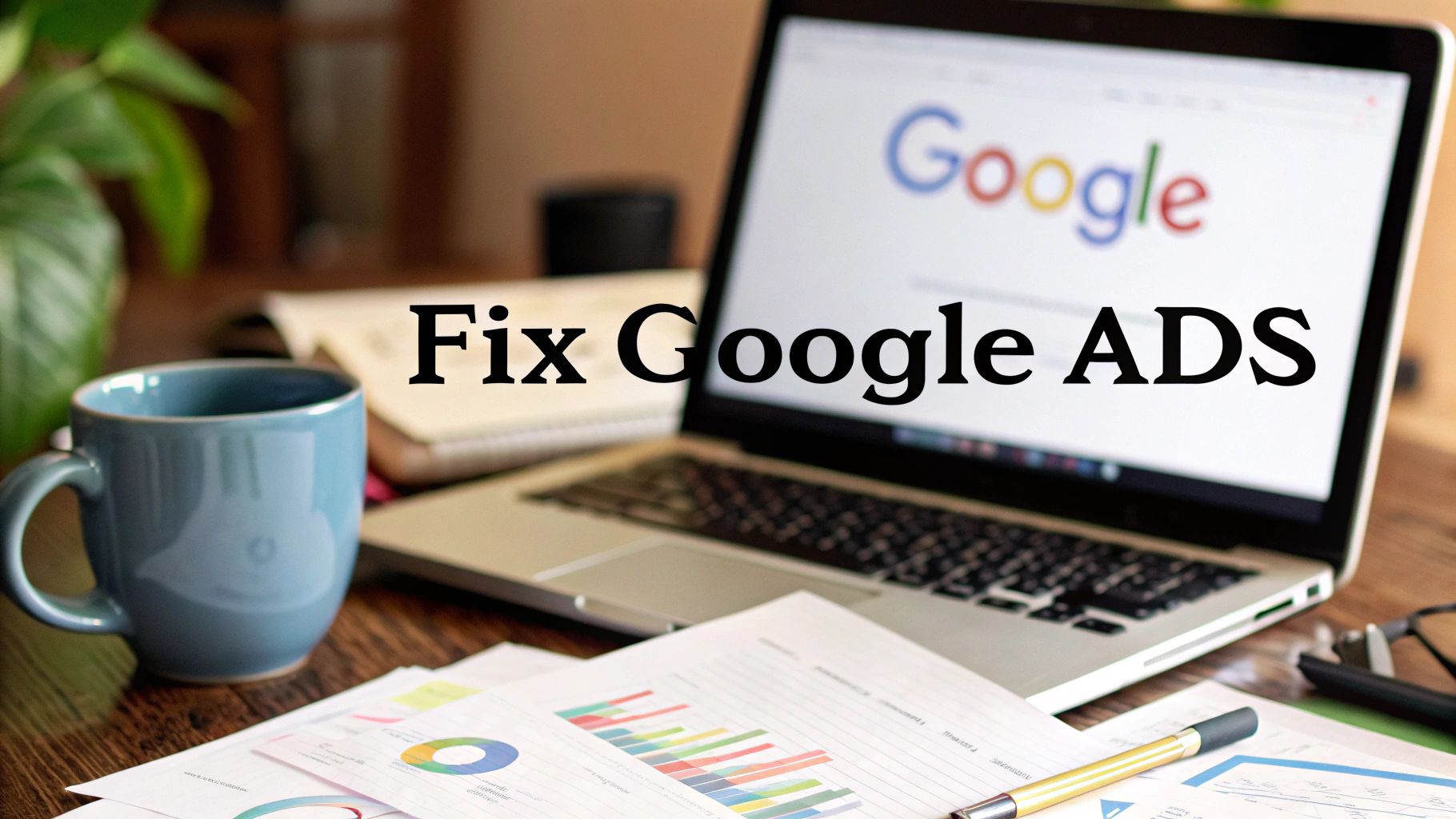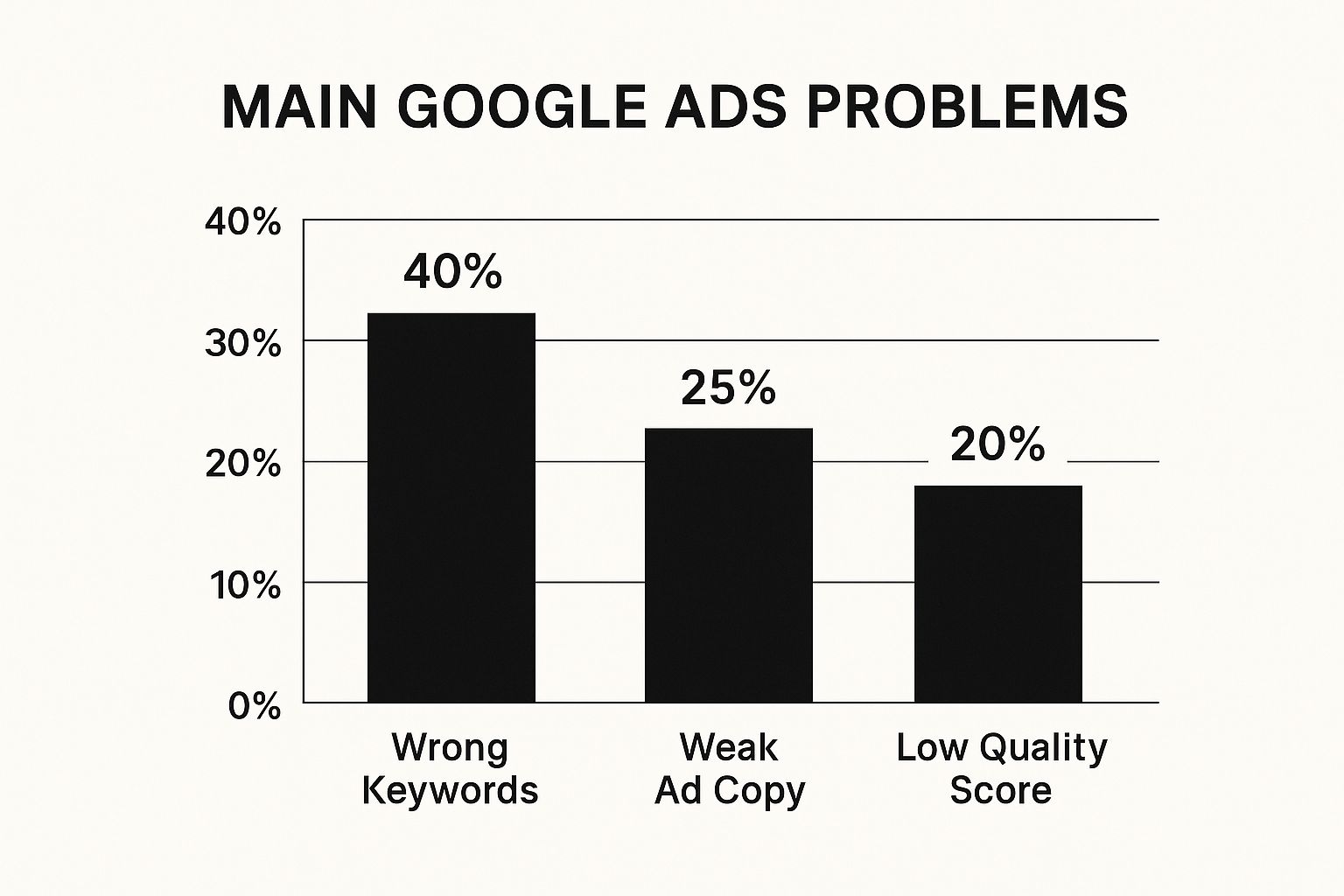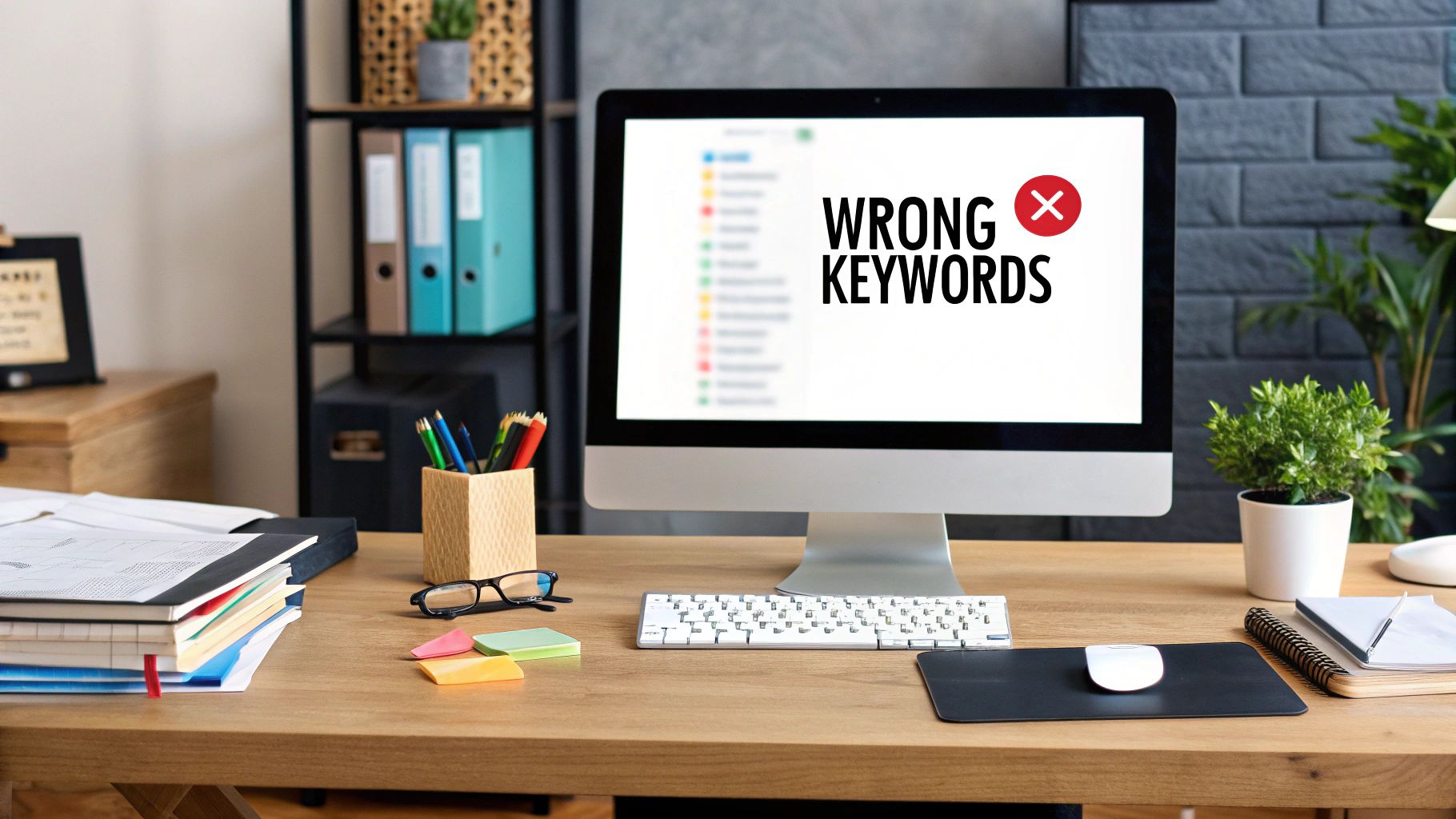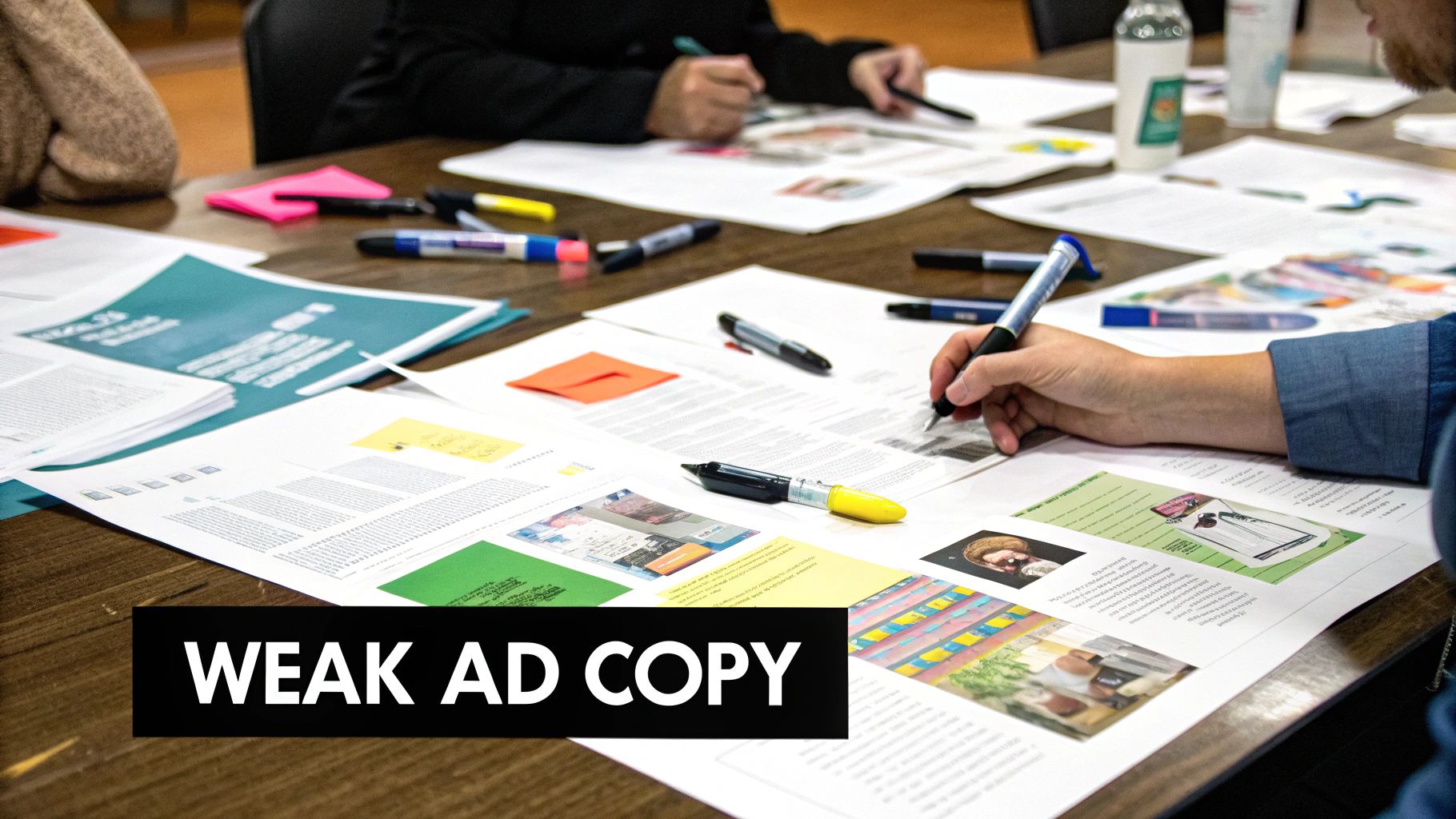July 25, 2025
Solving Your Google Ads Problems Today


It’s one of the most maddening feelings in marketing: you’re sinking money into a Google Ads campaign, but the returns just aren’t there. If this sounds familiar, don’t panic. Most of the time, poor performance isn't some great mystery. It’s usually a combination of a few common issues that, once you spot them, are entirely fixable.
Diagnosing Your Underperforming Google Ads
So, your Google Ads account feels like it's hemorrhaging cash with nothing to show for it. I've been there, and it's a classic sign that something is off-kilter in your setup. Before you start randomly changing bids or pausing campaigns in frustration, the first step is to play detective and figure out what’s really going on.
The problem could be hiding in a few different places. Are you actually reaching the right audience? Is your ad copy strong enough to even get a click? And what happens after someone clicks—is your landing page doing its job, or is it scaring potential customers away? Getting real about these questions is how you start turning things around.
Pinpointing the Core Issues
Most campaigns that are struggling suffer from the same handful of problems. Instead of guessing, it's best to have a mental checklist of the usual suspects.
Here’s where I always start my own investigations:
- Weak Keyword Strategy: This is a big one. Bidding on keywords that are way too broad, hyper-competitive, or just not relevant to what you're selling is the fastest way to burn through your budget.
- Poor Ad Relevance: Your ad copy has to connect with what the person searched for. If it doesn't, your click-through rates will tank, and Google will hit you with a low Quality Score, making you pay more for worse positions.
- Ineffective Audience Targeting: It doesn't matter how great your ad is if you're showing it to the wrong people. It’s like trying to sell steak at a vegan convention. You can learn more about dialing this in from our guide on Google Ads audience targeting.
- A Disconnected Landing Page: Your ad makes a promise, and your landing page has to deliver on it. If the page is slow, confusing, or feels totally disconnected from the ad, you’re just paying for bounces.
This image really drives home where the biggest problems usually lie, based on what we see across thousands of campaigns.

As you can see, keyword selection is a massive piece of the puzzle, responsible for 40% of campaign performance issues. It’s the foundation of everything.
To help you connect the dots in your own account, I've put together this quick-reference table. Think of it as a diagnostic chart for your campaigns. See a symptom you recognize? Here's where you should probably look first.
Common Google Ads Symptoms and Likely Causes
This table isn't exhaustive, but it's a solid starting point for tracing those frustrating symptoms back to their root cause. A methodical approach always beats random guesswork.
To truly pinpoint the issues causing your Google Ads to underperform, adopting a robust marketing campaign tracking process is indispensable. Without solid tracking, you're essentially flying blind, unable to connect spend to actual results. This systematic approach helps you see exactly where your funnel is breaking down, so you can apply targeted fixes instead of guessing.
So Clicks Are Coming In, But No One's Buying? Let's Fix Your Conversion Problem

This is one of the most frustrating feelings in Google Ads. The clicks are rolling in, your budget is being spent, but the sales, leads, or sign-ups just aren't happening. Your campaign feels more like a money pit than a profit machine. I’ve seen it a hundred times, and thankfully, it's almost always fixable.
When clicks don't turn into customers, the problem is rarely the ad itself. It's what happens after the click.
The path from an ad click to a real conversion is a tightrope walk. It starts with the promise you make in your ad copy and ends with the experience on your landing page. If there’s a mismatch anywhere along the way, you've lost them.
Your Ad and Landing Page Must Be a Perfect Match
If you take one thing away from this, let it be "ad scent." This is the golden rule. It means your landing page needs to feel like a seamless continuation of the ad someone just clicked.
Think about it from the user's perspective. They click an ad for "Emergency Plumbing Services" and get dumped on a generic homepage with info about kitchen remodels and commercial contracts. They're gone. Instantly. That disconnect destroys conversions faster than anything else.
Your landing page headline should practically mirror your ad headline. The imagery should be consistent, and the offer you promised should be right there, front and center. Focusing on how to improve website conversion rates is the most critical step you can take to turn those expensive clicks into actual revenue.
Write a Call-to-Action That People Actually Want to Click
Is your call-to-action (CTA) a boring, uninspired "Submit" button? Your CTA is the last little push a visitor needs. It has to be specific, feel urgent, and clearly state what they get in return.
Let's look at some simple but powerful upgrades:
- Instead of "Download," try "Get My Free Marketing Guide."
- Instead of "Buy," try "Claim My 20% Discount Now."
- Instead of "Contact Us," try "Request a Free, No-Obligation Quote."
See the difference? These small tweaks reframe the action around the user's benefit, which can have a huge impact on your conversion rate.
Your conversion rate is the true health metric of your campaign. If it's low, you're just paying for window shoppers. The goal isn't to collect clicks; it's to acquire customers profitably.
Double-Check Your Tracking—It Might Be Lying to You
You absolutely cannot fix what you can't measure. One of the sneakiest Google Ads problems I run into is busted conversion tracking. If your code is installed wrong or isn't firing when it should, your data is garbage.
This leads to disastrous decisions, like killing off your best keywords or pouring money into duds. You need to audit your setup. Use Google's Tag Assistant to make sure your tags fire correctly on your "thank you" page or after a form submission.
It’s also crucial to have a realistic idea of what "good" looks like. The average Google Ads conversion rate varies wildly by industry. As of 2025, the overall search average hovers around 7.52%. But look at the difference: some automotive repair campaigns hit a massive 14.67%, while finance and insurance might only see 2.55%. Knowing the benchmark for your field is key.
What to Do When Your Ad Performance is All Over the Place

Does your campaign performance chart look like a seismograph during an earthquake? You're not alone. One week, you’re on top of the world with great leads pouring in. The next, it’s radio silence. This kind of volatility is one of the most frustrating Google Ads problems I see, and it makes budgeting and forecasting feel like a total shot in the dark.
This is where advertisers often get into trouble. They panic. They slash bids, pause keywords, or shut down entire campaigns that were winners just a few days prior. Instead of reacting to every little bump and dip, the real fix is to dig in and figure out what’s actually causing the turbulence. The answers are usually a mix of things you can't control and things you absolutely can.
External Factors (The Stuff You Can't Control)
Sometimes, performance swings have nothing to do with your account. Your ads don’t exist in a vacuum; they're out there in the real world, influenced by all sorts of external forces.
Here are a few big ones to keep in mind:
- Seasonality: This is a huge one. If you're a tax accountant, you're going to be a lot busier in April than in August. Always ask yourself if your product or service has a natural ebb and flow throughout the year.
- Competitor Bidding: Did a well-funded new competitor just jump into your auctions? If they start bidding aggressively, your costs can spike and your ad positions can drop overnight, tanking your results without you touching a thing.
- News and Trends: A major news story or a viral trend can instantly change what people are searching for, pulling attention away from your industry and its commercial keywords.
Internal Issues (The Stuff You Can Fix)
While you can’t tell your competitors to calm down, you have total control over what’s happening inside your own Google Ads account. This is where you can build a more stable, resilient foundation. In my experience, two of the most common culprits for inconsistency are audience fatigue and sloppy A/B testing.
If you’re hammering the same remarketing list with the same ad creative for months, people will just start tuning you out. This is classic audience fatigue, and it shows up as declining click-through rates and poor conversion volume. You have to keep things fresh by rotating in new ad copy, new images, and even new offers.
A major trap when judging success is the unreliable nature of conversion rates. Some analyses show an average conversion rate around 4.8%, but this number can be misleading and varies wildly by industry. This inconsistency is exactly why setting realistic goals can be so tough. You can see more data on Google Ads conversion rates on firstpagesage.com.
On the flip side, bad A/B testing habits can create chaos. If you change five things in your ad at once, you have no idea which change actually made a difference. Was it the new headline? The different call-to-action? The new landing page? You'll never know. The key is to run structured, disciplined tests—one variable at a time—and look at performance over weeks, not just a single day.
Bringing Your Skyrocketing Ad Costs Back to Earth
https://www.youtube.com/embed/beJeJFHxnDI
Is your Google Ads budget disappearing faster than you can track it? It’s a gut-wrenching feeling, watching your Cost-Per-Click (CPC) tick upwards day after day, eating away at your profits. This is probably one of the most common headaches I see, but trust me, it’s not a lost cause. It's time to get a handle on your ad spend and make it work for you, not against you.
High costs are usually just a symptom of a bigger problem. You could be stuck in a bidding war for some crazy competitive keywords, or maybe your Quality Score has taken a nosedive, forcing you to pay a premium just to show up. Let's walk through the exact steps I take to wrestle those costs back down to earth without killing your traffic quality.
Get Aggressive with Negative Keywords
Your Search Terms Report is a literal gold mine for cutting costs. Seriously, if you aren't living in this report on a weekly basis, you're just throwing money away. This report tells you the exact queries people typed into Google right before clicking your ad.
I can almost guarantee you’ll find searches that are completely unrelated to what you actually offer. Every time someone searching for "free graphic design templates" clicks your ad for a paid design service, that’s cash down the drain. Each one of those irrelevant searches needs to be added to your negative keyword list. Immediately.
Think of negative keywords as the bouncers for your ad campaigns. They stand at the door and politely turn away all the unqualified traffic that would otherwise waste your budget. This is your first and most powerful line of defense against a bloated CPC.
Master Your Keyword Match Types
I get it, Broad Match can be tempting. But using it without a clear strategy is like throwing your wallet into a mosh pit and hoping for the best. With Google pushing automation so hard, more advertisers are leaning on it, but this often just leads to paying for clicks that have zero chance of ever converting.
Here’s how you can tighten things up and regain control:
- Exact Match: Reserve this for your absolute best-performing, highest-intent keywords. These are your "money" terms, the ones you know bring in conversions. Bid confidently on these.
- Phrase Match: This gives you a little more breathing room than Exact Match but keeps things highly relevant. It’s perfect for scooping up those closely related searches you might not have thought of.
- Broad Match: Use this one with extreme caution. My advice? Stick it in its own campaign with a very small, controlled budget, purely for discovering new keyword ideas. Never let it run wild in your main campaigns.
By simply being more deliberate with your match types, you instantly filter out a massive amount of irrelevant search traffic, which has a direct and immediate impact on lowering your costs.
Improve Your Ad Relevance and Quality Score
At the end of the day, Google wants to give its users a good experience. When you help them do that, they reward you. That reward is a high Quality Score, and it comes with one of the best perks in advertising: lower CPCs.
The logic is pretty straightforward: ads that are super relevant to the search query get higher click-through rates (CTR). A higher CTR signals to Google that your ad is a good match, which boosts your Quality Score. And a better Quality Score gets you a discount on your clicks.
The constant battle between CTR and CPC is real. I've seen campaigns with decent conversion rates ultimately fail because a low CTR and high costs meant they just couldn't get in front of enough people. If you want to dive deeper into the numbers, you can explore detailed Google Ads data on agencyanalytics.com to see how these benchmarks play out across industries.
Make your ads and landing pages hyper-specific to the keywords you're bidding on. Do that, and Google will thank you with cheaper, better traffic.
Thinking Ahead: Strategies for Long-Term Ad Success
Putting out fires in your Google Ads account is exhausting. If you're constantly reacting to problems, you're not growing. The real win comes when you build a campaign structure that's designed to prevent those fires in the first place. This is all about shifting your mindset from reactive to proactive. It’s how you build an advertising engine that doesn't just survive but actually thrives long-term.
This means you have to look past the day-to-day performance dips and start focusing on what will bring sustainable growth. By getting a handle on these more advanced strategies now, you can sidestep a lot of the common Google Ads problems down the road and build something truly resilient for your business.
Put Your First-Party Data to Work
With third-party cookies on their way out, your own customer data is quickly becoming gold. The smartest advertisers I know are already doubling down on their first-party data strategies to stay ahead of the curve. This is your chance to use things like email lists, customer purchase histories, and website visitor behavior to create remarketing audiences that absolutely kill it.
Forget about generic "all visitors" remarketing. You can get way more specific. For example, you could build segmented lists like:
- Your VIPs: Target your best past customers with exclusive access to new products or special loyalty offers.
- The Almost-Theres: Gently remind users who abandoned their carts what they left behind. Sometimes a small discount is all it takes to bring them back.
- Engaged Looky-Loos: Create a list of people who checked out key pages but never converted. You can then hit them with ads that tackle the exact reasons they might have hesitated.
Your first-party data is your private hotline to your most qualified audience. Using it for smart remarketing isn't just a good idea anymore—it's becoming essential for staying competitive and keeping your acquisition costs down.
This approach means you're always talking to a warm audience that already knows your brand, which massively boosts your chances of making the sale.
Find the Sweet Spot with Automation
Let's talk about automation. Google's big push with Performance Max (PMax) campaigns is a major topic of conversation, and for good reason. Automation can be an incredible tool, but just turning on the machine and hoping for the best is a recipe for wasted ad spend. The trick is knowing when to let the algorithm take the wheel and when to keep your hands on it.
PMax can be fantastic for scaling your campaigns once you've got a steady stream of conversion data. But if you're launching a brand-new product or targeting a super-niche audience? You’ll probably want the fine-tuned control over keywords and bidding that a standard Search campaign gives you.
A smart way to approach this is by starting with a rock-solid foundation of negative keywords. If you feed the automated system messy data, it will happily spend your budget on all sorts of irrelevant searches. To really nail this, you should read our deep-dive guide on building Google Ads negative keywords that will save you a ton of money.
Ultimately, the goal is to create a system where you're always learning. You use structured experiments to find that perfect mix of machine learning and human know-how that works for your business.
Common Questions About Fixing Google Ads

When your campaigns start to sputter, it's easy to feel like you've hit a brick wall. Trust me, we've all been there. The good news is that you're not the first person to run into these issues, and the fixes are usually pretty straightforward once you know where to look.
Let's dive right into some of the most frequent questions I hear from advertisers. Getting these sorted can save you a ton of time and get your campaigns back on the right track.
Why Is My Quality Score So Low and How Do I Fix It
A low Quality Score is basically Google's polite way of saying there's a serious mismatch somewhere in your campaign. It's almost always a breakdown between your keywords, your ads, and your landing page.
Here's what's likely causing the problem:
- Ad Relevance: Your ad copy just doesn't line up with the keywords you're bidding on. They feel disconnected.
- Expected Click-Through Rate (CTR): Your ads aren't grabbing attention or aren't compelling enough to earn the click.
- Landing Page Experience: The page someone lands on after clicking is slow, confusing, or doesn't deliver on what the ad promised.
To fix this, you need to go back to basics. Start by creating tighter, more focused ad groups where your keywords and ad copy are a perfect match. Then, work on writing more engaging ad copy that speaks directly to what the searcher wants. Finally, make sure your landing page loads lightning-fast and gives people exactly what they came for. Nailing these three things is the fastest way to boost your score and, more importantly, lower your ad costs.
What's Wrong if I Get Clicks but No Conversions
Ah, the classic "leaky bucket" problem. This one is frustrating because your ads are clearly working—they're getting clicks! But the issue almost always lies with what happens after that click.
First, take a hard, honest look at your landing page. Is your call-to-action (CTA) obvious and easy to spot? How does the page perform on a phone? Crucially, does the message on the page perfectly align with the promise you made in your ad?
Next, you absolutely have to double-check that your conversion tracking is set up correctly. If you can't trust your data, you're flying blind. It's also worth looking at your keyword intent. You might be paying for clicks from people searching for information (like "what is a PIM system") when you really need to attract people ready to buy (like "best PIM software for Salesforce").
This specific problem—clicks without conversions—is often the most expensive of all Google Ads problems. You're not just failing to make sales; you're actively paying for traffic that provides zero return on your investment. Fixing this disconnect is non-negotiable for a profitable campaign.
Should I Use Google's Automated Bidding Strategies
Look, automated bidding can be a game-changer, but it's not a magic "set it and forget it" solution. Think of it as a powerful machine that needs the right fuel to run. That fuel is data.
Jumping into a "Maximize Conversions" or "Target CPA" strategy on a brand-new campaign is a surefire way to burn through your budget with little to show for it.
You need to feed the algorithm first. A good rule of thumb is to have at least 30-50 conversions in a 30-day window before you even consider letting Google take the wheel. I always recommend starting new campaigns with Manual or Enhanced CPC to gather that initial performance data yourself.
Once you have a steady stream of conversions, you can dip your toes in by testing an automated strategy on a single campaign. This way, you're teaching the system what a good lead looks like for your business before you hand over the keys.
Feeling overwhelmed trying to fix these Google Ads problems by hand? keywordme makes it a whole lot easier. Our tool helps you quickly find and eliminate wasteful search terms, discover high-converting keywords, and get your match types in order—all in a few clicks. Turn hours of spreadsheet drudgery into minutes of smart optimization. Stop juggling data and start making better decisions with our free trial.


.svg)